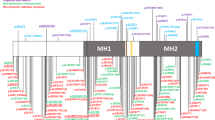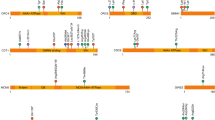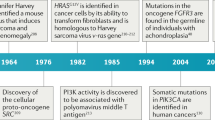Abstract
Hereditary multiple exostoses (EXT) is an autosomal dominant condition characterized by short stature and the development of bony protuberances at the ends of all the long bones. Three genetic loci have been identified by genetic linkage analysis at chromosomes 8q24.1, 11p11–13 and 19p. The EXT1 gene on chromosome 8 was recently identified and characterized. Here, we report the isolation and characterization of the EXT2 gene. This gene shows striking sequence similarity to the EXT1 gene, and we have identified a four base deletion segregating with the phenotype. Both EXT1 and EXT2 show significant homology with one additional expressed sequence tag, defining a new multigene family of proteins with potential tumour suppressor activity.
This is a preview of subscription content, access via your institution
Access options
Subscribe to this journal
Receive 12 print issues and online access
$209.00 per year
only $17.42 per issue
Buy this article
- Purchase on Springer Link
- Instant access to full article PDF
Prices may be subject to local taxes which are calculated during checkout
Similar content being viewed by others
References
Solomon, L. Bone growth in diaphyseal acalasis. J. Bone Joint Surg. 43, 700–716 (1961).
Hennekam, R.C. Hereditary multiple exostoses. J. Med. Genet. 28, 262–266 (1991).
Schmale, G.A., Conrad, E.U. & Raskind, W.H. The natural history of hereditary multiple exostoses. J. Bone Joint Surg. Am. 76, 986–992 (1994).
Leone, N.C. et al. Hereditary multiple exostosis. J. of Hered. 78, 171–177 (1987).
Luckert-Wicklund, C., Pauli, R., Johnston, D. & Hecht, J. Natural history of hereditary multiple exostoses. Am. J. Med. Genet. 55, 43–46 (1995).
Cook, A. et al. Genetic heterogeneity in families with hereditary multiple exostoses. Am. J. Hum. Genet. 53, 71–79 (1993).
Kooth, R., Macklin, M. & Hilbish, T. Diaphyseal aclasis (multiple exostoses) on Guam. Am. J. Hum. Genet. 13, 340–347 (1961).
Ludecke, H.J. et al. Molecular dissection of a contiguous gene syndrome: localization of the genes involved in the Langer-Giedion syndrome. Hum. Mol. Genet. 4, 31–36 (1995).
Wu, Y.Q. et al. Assignment of a second locus for multiple exostoses to the pericentromeric region of chromosome 11. Hum. Mol. Genet. 3, 167–171 (1994).
Wuyts, W. et al. Refinement of the multiple exostoses locus (EXT2) to a 3-cM interval on chromosome 11. Am. J. Hum. Genet. 57, 382–387 (1995).
Le Merrer, M. et al. A gene for hereditary multiple exostoses maps to chromosome 19p. Hum. Mol. Genet. 3, 717–722 (1994).
Hecht, J.T. et al. Hereditary multiple exostoses and chondrosarcoma: linkage to chromosome 11 and loss of heterozygosity for EXT-linked markers on chromosomes 11 and 8. Am. J. Hum. Genet. 56, 1125–1131 (1995).
Raskind, W.H., Conrad, E.U., Chansky, H. & Matsushita, M. Loss of heterozygosity in chondrosarcomas for markers linked to hereditary multiple exostoses loci on chromosomes 8 and 11. Am. J. Hum. Genet. 56, 1132–1139 (1995).
Ann, J. et al. Cloning of the putative tumour suppressor gene for hereditary multiple exostoses (EXT1). Nature Genet. 11, 137–143 (1995).
Lovett, M. Fishing for complements: finding genes by direct selection. Trends Genet. 10, 352–357 (1994).
Smith, M.W. et al. A sequence-tagged site map of human chromosome 11. Genomics 17, 699–725 (1993).
Quackenbush, J. et at. An STS content map of human chromosome 11: localization of 910 YAC clones and 109 islands. Genomics 29, 512–525 (1995).
Cohen, D., Chumakov, I. & Weissenbach, J. A first-generation physical map of the human genome. Nature 366, 698–701 (1993).
Qin, S. et al. A chromosome 11 YAC library. Genomics 16, 580–585 (1993).
James, M.R. et al. A radiation hybrid map of 506 STS markers spanning human chromosome 11. Nature Genet. 8, 70–76 (1994).
Longmire, J. et al. Construction and characterization of partial digest libraries made from flow-sorted human chromosome 16. Genet. Anal. Tech. Appl. 10, 49–76 (1993).
Evans, G. & Lewis, K. Physical mapping of complex genomes by cosmid multiplex analysis. Proc. Natl Acad. Sci. USA 86, 5030–5034 (1989).
Smith, M.W., Holmsen, A.L., Wei, Y.H., Peterson, M. & Evans, G.A. Genomic sequence sampling: a strategy for high resolution sequence-based physical mapping of complex genomes. Nature Genet. 7, 40–47 (1994).
Lovett, M., Kere, J. & Hinton, L.M. Direct selection: a method for the isolation of cDNAs encoded by large genomic regions. Proc. Natl. Acad. Sci. USA 88, 9628–9632 (1991).
Atlschul, S., Gish, W., Miller, W., Meyers, E. & Lipman, D. Basic local alignment search tool. J. Mol. Bioi. 215, 403–410 (1990).
Altschul, S., Boguski, M., Gish, W. & Wootton, J. Issues in searching molecular sequence databases. Nature Genef. 6, 119–129 (1994).
Lennon, G., Auffray, C., Polymeropoulos, M. & Soares, M. The I.M.A.G.E. Consortium: An integrated Molecular Analysis of Genomes and their Expression. Genomics (in the press).
Frohman, M. Rapid amplification of complementary DNA ends for generation of full-length complementary DNAs: thermal RACE. Meth. Enzymol. 218, 340–356 (1993).
Kozak, M. An analysis of 5′-noncoding sequences from 699 vertebrate messenger RNAs. Nucl. Acids Res. 15, 8125–8148 (1994).
Del Mastro, R. et al. Human chromosome-specific cDNA libraries: New tools for gene identification and genome annotation. Genome Res. 5, 185–194 (1995).
Levy-Lahad, E. et al. Candidate Gene for the Chromosome 1 Familial Alzheimer's Disease Locus. Science 269, 973–977 (1995).
Evans, G.A. in Genome Analysis: A Laboratory Manual. (eds. Birren, B., Green, E., Heiter, P., Klapholz, S. & Myers, R.) (Cold Spring Harbor Laboratory Press, Cold Spring Harbor, New York, in the press).
Orita, Y., Sekiya, T. & Hayashi, K. Rapid and sensitive detection of point mutations and DNA polymorphisms using the polymerase chain reaction. Genomics 5, 874–879 (1989).
Author information
Authors and Affiliations
Corresponding author
Rights and permissions
About this article
Cite this article
Stickens, D., Clines, G., Burbee, D. et al. The EXT2 multiple exostoses gene defines a family of putative tumour suppressor genes. Nat Genet 14, 25–32 (1996). https://doi.org/10.1038/ng0996-25
Received:
Accepted:
Issue Date:
DOI: https://doi.org/10.1038/ng0996-25
This article is cited by
-
Functional Impairment of Hip Joint and Activities of Daily Living Failure in Patients with Multiple Hereditary Exostoses
Indian Journal of Orthopaedics (2022)
-
An unusual diagnosis for an usual test
Italian Journal of Pediatrics (2020)
-
Identification of a 6-month-old baby with a combination of WAGR and Potocki-Shaffer contiguous deletion syndromes by SNP array testing
Hereditas (2020)
-
Relationship between bone disorders and stroke
Neurological Sciences (2020)
-
Radiographic characteristics of the hip joint in skeletally mature patients with multiple hereditary exostoses
Skeletal Radiology (2020)



